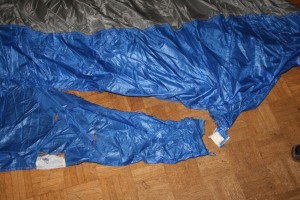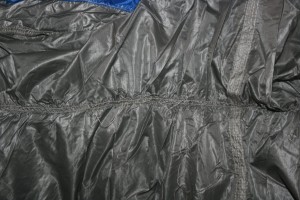Depending on where and what you jump you will end up in a tree eventually. I think there are very few jumpers that have more than a few hundred jumps and didn’t land in a tree at least once.
Landing in a tree isn’t actually that bad, on most treelandings that I’ve seen, the jumper walked away unharmed, and only a few did serious damage to their equipment, although sometimes things end up going bad. The main issue is that the outcome mainly depends on luck, since there are so many factors that cannot be controlled.
There is some stuff to know about treelandings, and how you can influence their outcome in your favour, so below there’s a list of Do’s and Don’ts that would raise your chances of being unhurt, but due to the fact that treelandings happen because something went wrong way before you were sitting in that tree, be it a low pull, strong winds, offheadings, linetwists, other malfunctions, you will most likely end up only being able to use a few of them.
Do’s and Dont’s
- Protect the vital parts of your body with the less important stuff. Use your hands and legs to protect your torso and head. Best to accomplish this is to ball up with your legs tucked up and crossed, using your hands to protect your head and face. This of course works best if you hit the tree frontal, if you got twists and are going backwards it obviously doesn’t help that much.
- Flare! or go in deep brakes. Someone once said “Even when you’re about to land on a cop, don’t forget to flare.”.
- “Land” facing the wind. Going downwind is going to hurt more…
- You want to keep your canopy flying as long as possible, and get it stuck on the tree, to prevent you from falling. Pick a tree and try to get your canopy hang up on it, try to hit it in a way that so that your canopy contacts first, or at least at the same time as your body. (assuming you come from side and not from straight above)
- If its thick forest, DO NOT go in between trees, doing that you got a pretty good chance that your canopy isn’t snagged but collapsed and you fall to the ground, or your canopy is snagged on one side and turns into the ground.
- If the terrain is sloped, DO NOT go downhill into trees! If you go downhill your body will hit the treetops first, so basically your forward motion is stopped and your canopy will overshoot you and will not carry any load any more. So from there you would just fall. Go parallel to the slope. (even uphill is better than downhill)
Body armour
- The more body armour you wear, the better. If you crash into something, you rather want to be dressed up as robocop than being naked. A spine protector can make a huge difference if you go into a tree flying backwards with linetwists.
- Wear some kind of glasses! Your eyes are kind of sensitive when it comes to poking them with branches, having something in between them and the tree is a good thing. Skiing goggles do a really good job, especially the ones with the double anti fog glasses, they cover a quite big area of your face and its really hard to push something through.
- A full face helmet is for sure better than an open one.
In the tree
- Get a good hold and secure yourself if possible.
- Check yourself for injuries.
- Call someone to help you.
- If possible open leg straps a bit keep more blood circulating in your leg and try to move your legs a bit to not build up a suspension trauma so fast. (more on this a little further down) This is especially important if you’re going to be stuck up there for a longer time.
Getting down
- If you think you can climb down on your own, WAIT a few minutes, calm down, and think again if its safely possible and if you’re really capable of doing so.
- Your health always has a higher priority than your equipment!
- Carry a small box of dental floss! Dental floss is the shit when you’re stuck in a tree, its very light and small to carry around, it has a quite high tensile strength, you get 50-100m nicely rolled up in a box. When you’re stuck in a tree you can tie the end to a branch or something, throw the box down, so someone on the ground can attach a rope for you to pull up.
- You should have basic knowledge about how to safely rappel. If you don’t already have basic rope climbing skills, maybe think about going to the climbing gym and learn at least the basics.
Suspension trauma
Suspension trauma happens if a person is held in an upright position (eg. in a harness) without moving for a period of time. This period is rather short, suspension trauma can build up within 20 minutes. Putting weight on the legs, moving them, widening a restricting harness, raising legs to a sitting position helps to delay suspension trauma.
“Typical symptoms are pallor, sweating, shortness of breath, blurred vision, dizziness, nausea, hypotension and numbness of the legs.” [1] and fainting. Injuries will of course worsen the situation.
Dealing with suspension trauma is kind of complicated, on one side, the pooled blood in the legs has to be put back in the system, or the suspension trauma will get continue, on the other hand, putting the blood back in the system too fast, eg. by lying the person down on the floor will lead to cardiac arrest when all the low-oxygen blood and all the bad stuff that collected in the legs suddenly goes back to the heart and brain. The whole thing gets even more complicated when the person is injured and or unconscious.
So if you get someone off a tree and you suspect a suspension trauma, do not lie them down! Get their upper body elevated, monitor health signs and get professional help.
[1] en.wikipedia.org/wiki/Suspension_trauma
Aftermath
 Rips in canopy material are pretty common after a treelanding. As long as they are small and not in a high stress area they can be patched up with ripstop tape, else they must be properly patched right away.
Rips in canopy material are pretty common after a treelanding. As long as they are small and not in a high stress area they can be patched up with ripstop tape, else they must be properly patched right away.
Damaged lines must be replaced right away. If the line is only dirty (eg. green) from the tree its fine, but any broken strands or stitching has to be replaced.
Tree gum is pretty nasty stuff. Try to limit the area that comes in touch with it. If you find some stains, try to not contaminate other pieces of fabric with it to limit the damage. When you already found some when you got the canopy off the tree, do not stash the stained pieces with the rest of the canopy.
 Big stains will have to be cut out and patched. Smaller stains can be treated with climbing chalk. Scrap off as much tree gum as possible and take a good amount of chalk and rub it on the canopy fabric until it stops being sticky. Rather use too much chalk than too little. Do not use anything other than chalk! Dust, sand, etc. will damage the canopy fabric, while chalk does not do any harm to it.
Big stains will have to be cut out and patched. Smaller stains can be treated with climbing chalk. Scrap off as much tree gum as possible and take a good amount of chalk and rub it on the canopy fabric until it stops being sticky. Rather use too much chalk than too little. Do not use anything other than chalk! Dust, sand, etc. will damage the canopy fabric, while chalk does not do any harm to it.
Pulled stitching on canopy is also quite common. If the thread is still intact and the only a very small amount has been pulled out of the seam you can try realigning it with a toothpick or similar. If the thread is broken, or the stitching has been pulled excessively it has to be restitched.
Butter can also be used for removing tree gum. Butter up the gummy part and let it sit overnight. Makes it lot easier to scrape off the gum.
i personally would not recommend putting butter on a canopy. since butter itself can be kind of hard to get off again (google “gelvenor stain first aid” for how to get rid of butter on f111), and leaving it in the fabric will also degrade it to a certain extend…
I heard that baby powder also does it quite fine.